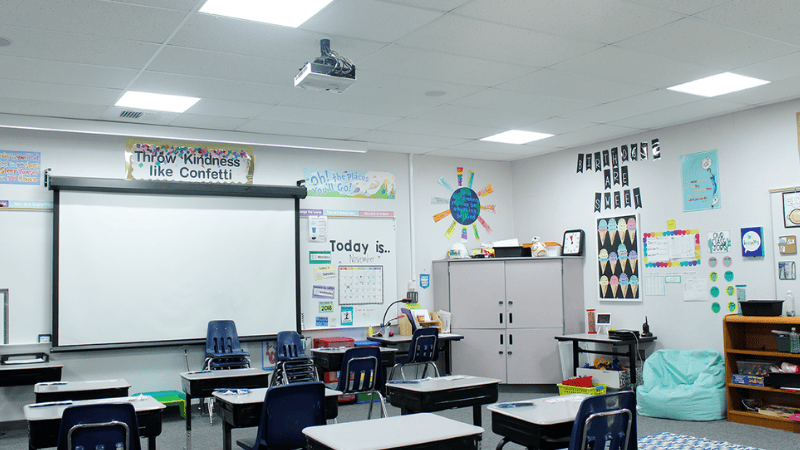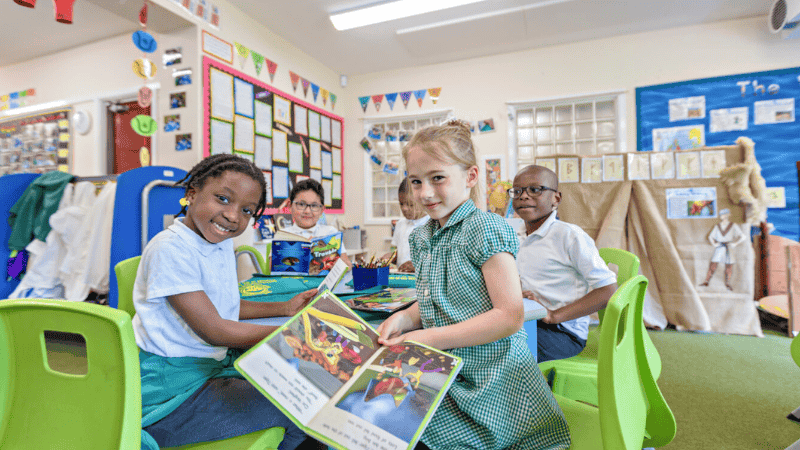If you are looking wholesale lighting solutions, click here.

The importance of lighting for learning activities is unquestionable in the classroom. But do you know what impact takes place on students’ minds by lighting? A research study proved that lighting influences students’ mood, behavior, and academic performance.
But the question is what kinds of LED bulbs and fluorescent lights are suitable for the classroom? And how can school administration and teachers improve class lighting to increase students’ learning ability?
Among all types of lighting available in the market, conventional white fluorescent lighting is ideal for providing bright white light. However, some people may experience fatigue, eye strain, and headaches from usually bright fluorescent light.
So, what is the right classroom lighting, and how does it affect students’ learning capabilities? Let’s find out.
Understanding how classroom lighting impacts students is crucial for creating an optimal learning environment.
Classroom lighting does more than illuminate. A suitable lighting environment affects students’ emotional and cognitive development.
Install optimal lighting solutions for students to improve their energy level and concentration and develop a learning atmosphere in class. At the same time, poor lighting can cause greater visual discomfort, lower performance, and higher stress.

The most common classroom lighting is fluorescent lighting due to its high energy efficiency. However, fluorescent lighting fixture frame usually emits flickering and buzzing sounds, which may be uncomfortable and distract students’ attention from learning. Similarly, dimmer fluorescent light bulbs also make it challenging for students to see the teacher’s lecture on board due to the production of high glare.
Good lighting is essential to enhancing students’ academic performance. An NCBI study proved that classrooms with better lighting improve test scores, reading speed, and errors.
On the other hand, glare or dim lighting conditions can cause headaches, eyestrain, and discomfort, leading to disrupted learning environments. Furthermore, poor lighting hurts the alertness of students, resulting in a lack of concentration and drowsiness during class.
Moreover, research has proved that attention deficit hyperactivity disorder (ADHD) symptoms arise in students due to inadequate lighting, which weakens the ability to learn and concentrate on studies among students.

So, what are the right alternatives to fluorescent lighting fixture frames that can enhance the learning experience? Below are the top 3 recommendations for upgrading classroom light fixtures:
Establishing classrooms with more exposure to natural lighting can improve students’ concentration. According to research, sunlight in educational places enhances students’ cognitive functioning, productivity, and learning mood. Consider the design and infrastructure of classrooms to allow more natural light. In this way, educators can have a classroom that supports more academic success and well-being.
To create a well-lit room with more exposure to natural light, avoid heavy draperies, assess lighting quality, and install more skylights and windows.
Moreover, arranging desks and seating so that students face away from the sunlight reduces glare. Such arrangements and installations can improve lighting quality to benefit students in your classroom.

Another popular alternative to fluorescent lights is LED bulbs. This type of lighting produces better-quality light for a longer period due to less heat emission. The amazing advantage of LED lights is their dimmable feature, which enables you to adjust lighting in a room according to your needs.
While picking LED lighting for educational setups and classrooms, consideration of color temperature (measured in Kelvin) is essential to getting the desired “warm” or “cool” effect of light.
We recommend using LED bulbs with a color temperature of 4000K-5000K for classrooms because such lighting promotes students’ focus and alertness.
Incorporating light control and dimmers into the classroom lighting setup enables teachers and students to adjust the classroom light depending on the educational activity. By facilitating educators to tune the lighting levels, dimmers play a role in supporting inclusive education.
Dimmable LED and fluorescent lighting prevent glare during activities that need less light, such as watching digital devices for educational purposes, by modulating light intensity. Moreover, installing light controls can help conserve energy, making lighting practices sustainable for educational institutions.

Here are some amazing creative tips to optimize classroom lighting and establish a conducive learning setup for students:
Choose classroom ceiling lights while considering students’ comfort, as lighting’s primary purpose is facilitating them. Go for LEDs and fluorescents with diffusers to get uniformly distributed light and minimal glare.
Use split lighting zones to make your classroom suitable for multiple activities. A well-lighted classroom always comes with some light zones.
It would help if you combined overhead, task, and natural lights to have a multiple-lighting zone classroom. Task lights are proven more effective for students who read and work efficiently in additional light.
The right choice of the light source’s color temperature plays a role in elevating mood and concentration on studies. Using cooler-temperature lights boosts alertness, while warmer tones improve the sense of relaxation.
However, finding a suitable balance between warm and cool lighting is key to creating a comfortable learning setup.

Installation of LED lights with a high CRI (color rendering index) reduces flicker, making the lighting solution more suitable for the classroom. Moreover, choosing light fixtures with less or no light emission can improve students’ concentration and focus.
Occupancy sensors are also amazing, easy-to-use, energy-efficient lighting solutions. When installed, these sensors turn off lights automatically when not in use. They detect occupancy and inactivate light for a specific time period.
There are certain mistakes that educational administrations make while designing classroom lighting setups. To avoid those mistakes, you must be aware of them. The following are some mistakes you need to avoid while planning classroom lighting:
Light glare is one of the common issues that produces visual difficulty and discomfort in the classroom. The main reason for this glare is overhead lights, which produce reflections over shiny surfaces and screens due to their placement directly above students.
To avoid this, choose indirect lighting solutions. You can do so by placing light at an angle relative to students’ seating arrangement and bulbs containing diffused light to reduce glare.

Poorly distributed light is also a problem that needs to be addressed. Uniform light distribution in a room makes it suitable for learning and workspaces.
To achieve uniform light distribution, we recommend using multiple light sources. We suggest combining ceiling and task lights with natural light sources to create an energy-booster, balanced learning environment.
Flickering lights and buzzing sounds are also responsible for students’ lack of concentration in class. Choosing LED lights with high CRI is important to eliminate these flickering and humming distractions.
The best solution to avoid such issues is to maintain lighting fixtures regularly. Bulbs and light fixtures usually produce flickering and noise issues when they get damaged, so make sure to repair or replace the bulbs regularly.

Inadequate lighting control can also increase students’ discomfort. This problem leads to inefficient energy use, which can stress energy expenditures.
Incorporating timers, occupancy sensors, and dimmers helps control light usage by reducing energy consumption. Moreover, students need to be educated to turn off extra lights to conserve energy.
Regular maintenance is a key factor in keeping classroom lighting efficient and functional. Showing neglect in repairing or replacing faulty bulbs and fixtures may lead to higher energy costs and poor classroom-quality light.
The administration of educational institutes must have a plan for regular maintenance of classroom lighting systems. This easy and regular practice can increase the life of bulbs and lighting fixtures. Moreover, it creates a better learning environment and promotes energy efficiency.

The white color light is better for studying due to having a high color temperature. LED lights with high temperature cooler tones are more effective for a learning environment.
The lighting requirements for a classroom may vary depending on the activity and subjects. If you plan a classroom for tutoring sessions or physical exercises, the illuminance should be 300 lux. However, 500 lux and 700 lux are standard illuminance requirements for reading rooms and art classes.

The lighting in a classroom plays a significant role in creating an environment suitable for concentration, learning, and students’ overall well-being. Educational administrations can improve lighting quality by avoiding common mistakes, incorporating multiple light sources and occupancy sensors, choosing the right color temperature, and regular maintenance.
Moreover, choosing the right classroom lighting fixtures and managing uniform light distribution is crucial. These strategies can improve your student’s academic performance, comfort, and health. In short, all these steps of better lighting effectively make the classroom a productive and inviting space.
At Risun, we offer a wide range of high-quality, energy-efficient classroom lighting solutions. Our lights are designed with the student’s well-being and comfort in mind, accurately balancing classroom lighting functionality and aesthetics.
We have everything from LED lighting fixtures to light control and sensors to optimize the learning environment for students in your classroom. Contact us today to learn more about our products and supply chain management service.
Comprehensive Lighting Solutions for MRO Wholesalers and Professionals
send your inquiry
Hi, I'm the author of this post, and I have been in this field for more than 15 years. If you want to wholesale lighting fixtures or lighting related product, feel free to ask me any questions.
Learn More >>Download our catalog to view all of our lighting products.
Ready to get started ?
Send Your InquiryOur team will get back to you promptly

please
download
Get notified about new products
Our team will get back to you promptly!
Add your first comment to this post